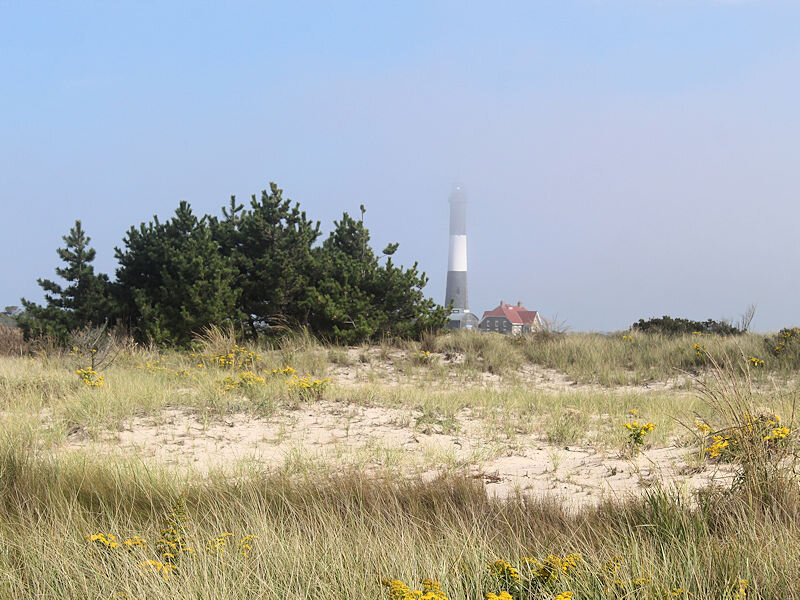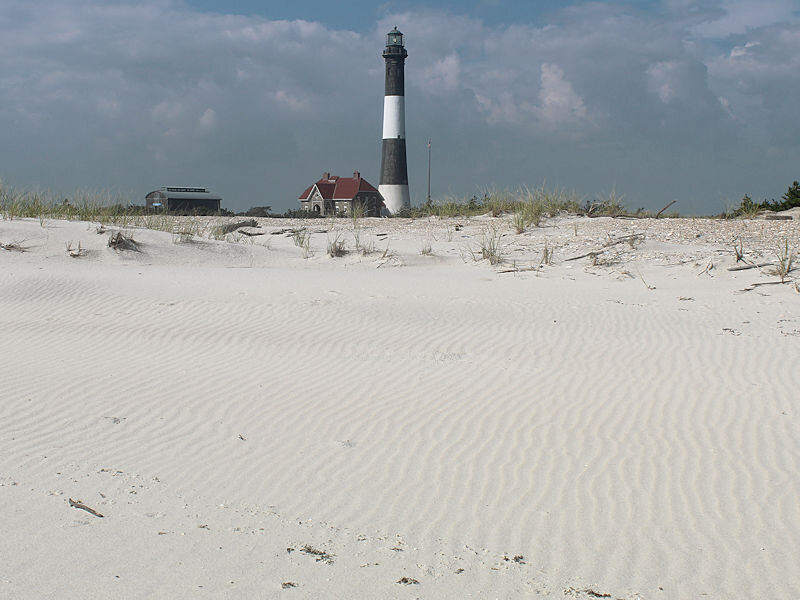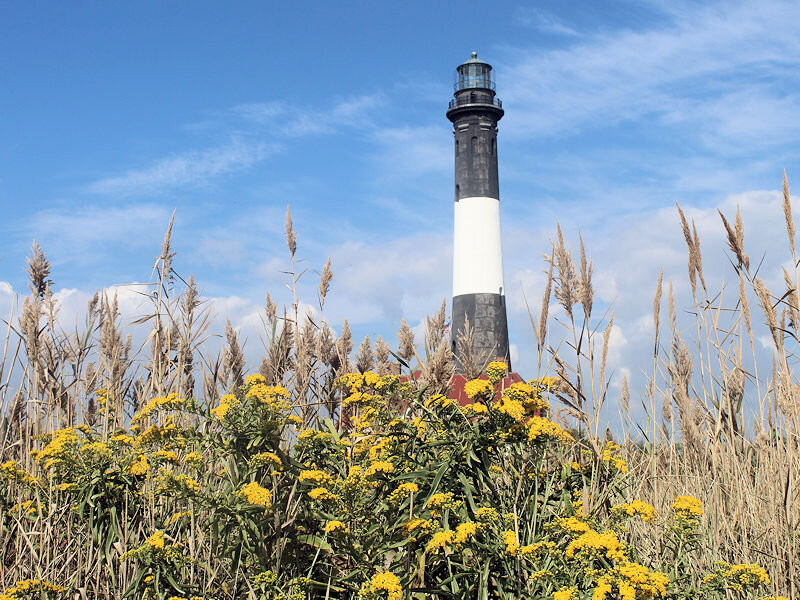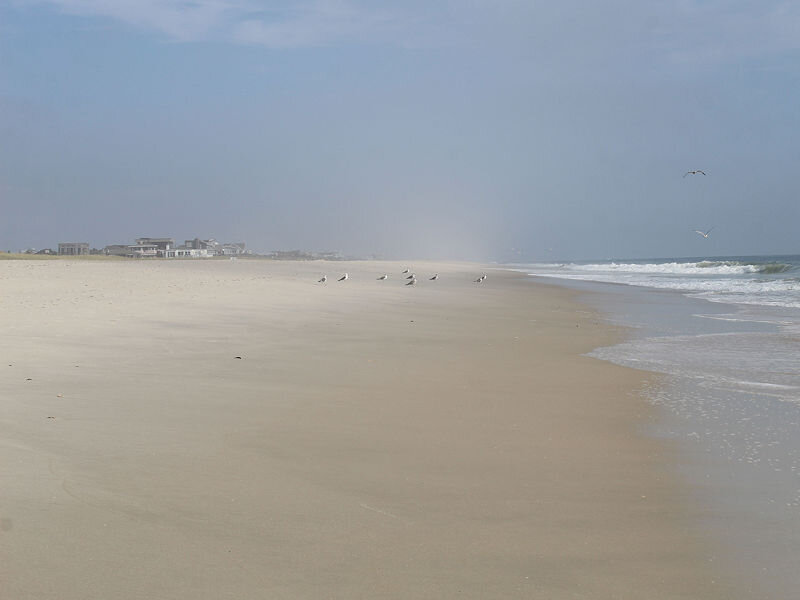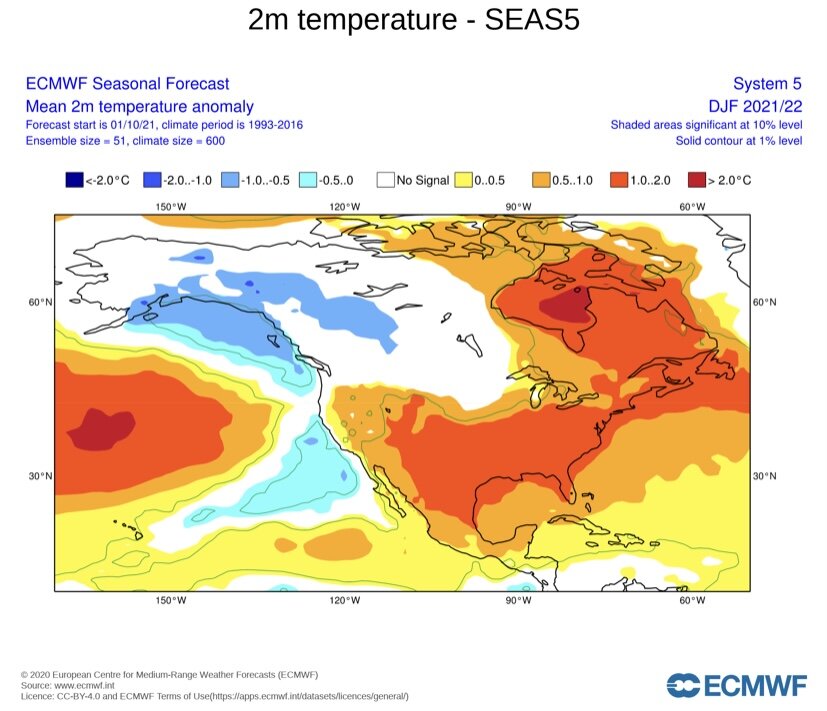-
Posts
23,218 -
Joined
Content Type
Profiles
Blogs
Forums
American Weather
Media Demo
Store
Gallery
Everything posted by donsutherland1
-
Same in Mamaroneck.
-
Morning thoughts… It will be mostly cloudy and cooler. High temperatures will likely reach the middle and upper 60s in most of the region. Likely high temperatures around the region include: New York City (Central Park): 66° Newark: 69° Philadelphia: 70° Normals: New York City: 30-Year: 67.0°; 15-Year: 68.1° Newark: 30-Year: 68.6°; 15-Year: 70.0° Philadelphia: 30-Year: 69.8°; 15-Year: 70.9° Tomorrow will be another cool day with some showers, particularly during the late morning and afternoon. Rainfall totals should be light. Philadelphia, Newark, and New York City will likely see 0.25” or less. Heavier amounts will likely be confined to eastern New Jersey and across Suffolk County on Long Island. A generally warmer than normal regime will continue into at least mid-month.
-
Today was another unseasonably warm day. Temperatures rose into the middle and upper 70s across the region today. Newark reached 70° for the 163rd time this year. As a result, 2021 is tied for 13th place with 2001 and 2011. Tomorrow will be slightly cooler. Temperatures will generally top out in the middle and upper 60s. Some rain is possible, especially during Sunday afternoon. Overall, the generally warm regime will continue into at least mid-month. In the Northern Plains and Upper Midwest, the first week of October was exceptionally warm. Some temperatures and rankings for the first week of October: Billings: 63.9° (5th warmest) Bismarck: 64.5° (2nd warmest) Duluth: 60.5° (old record: 59.3°, 1963) Fargo: 63.9° (tied, 3rd warmest) Glasgow, MT: 64.4° (2nd warmest) Green Bay: 64.4° (3rd warmest) International Falls: 60.1° (3rd warmest) Madison: 67.2° (4th warmest) Milwaukee: 68.4° (3rd warmest) Minneapolis-St. Paul: 66.0° (5th warmest) Fall 2021 will likely be wetter to much wetter than normal in the northern Middle Atlantic region. Since 1869, there have been 9 August cases where New York City picked up 20.00" or more rainfall during the summer. Two thirds of those cases (and 4/5 of those with summer mean temperatures of 73.0° or above) had 17.00" or more fall precipitation in New York City. 2011 is probably the closest match in terms of precipitation and a nearly identical summer mean temperature. Mean fall precipitation for those 9 cases was 14.86". The median was 17.35". The 1991-2020 normal value is 12.27". Following very wet July-September periods, winter (December-February) precipitation has typically been near or below normal. The most recent exception was winter 2018-19. The ENSO Region 1+2 anomaly was 0.0°C and the Region 3.4 anomaly was 0.0°C for the week centered around September 29. For the past six weeks, the ENSO Region 1+2 anomaly has averaged +0.07°C and the ENSO Region 3.4 anomaly has averaged -0.28°C. Neutral ENSO conditions will likely yield to La Niña conditions later this month. The SOI was +13.08 today. The preliminary Arctic Oscillation (AO) figure was -0.524 today. On October 6 the MJO was in Phase 5 at an amplitude of 2.147 (RMM). The October 5-adjusted amplitude was 1.963 (RMM). Based on sensitivity analysis applied to the latest guidance, there is an implied 83% probability that New York City will have a warmer than normal October (1991-2020 normal). October will likely finish with a mean temperature near 62.0° (4.1° above normal).
-
Today proved to be another great late-season beach day with strong sunshine and temperatures in the 70s.
-
The National Blend of Models has about a quarter inch of rain, mainly from afternoon showers. There remains higher than usual uncertainty as to the potential development and placement of an inverted trough.
-
-
Morning thoughts… After some early fog in a few locations, today will be partly sunny and warm. High temperatures will likely reach the middle and even upper 70s in most of the region. Likely high temperatures around the region include: New York City (Central Park): 73° Newark: 77° Philadelphia: 77° Normals: New York City: 30-Year: 67.4°; 15-Year: 68.6° Newark: 30-Year: 69.0°; 15-Year: 70.4° Philadelphia: 30-Year: 70.2°; 15-Year: 71.3° A generally warmer than normal regime will continue into at least mid-month.
-
Right now, it looks as if showers and light rain will arrive Sunday morning near 8 am and on and off light rain will persist into the evening. Total rainfall will be somewhere around 0.50”. I wish things looked better. We’ll see what the overnight guidance shows.
-
Under partly sunny skies, temperatures rose into the lower and middle 70s today. Newark reached 70° for the 162nd time this year. As a result, 2021 is tied for 15th place with 1959 and 1989. Tomorrow will be variably cloudy and very warm. The temperature will likely reach the middle and possibly upper 70s. Slightly cooler air will return for the weekend. Some rain is possible on Sunday. Overall, the generally warm regime will continue into at least mid-month. Bismarck concluded its 2nd warmest opening week of October on record with a mean temperature of 64.5°. The record of 65.1° was set in 2011. In addition, the October 1-7 average high temperature was 82.3°. That set a new 7-day October record. The old record of 81.9° was set during October 7-13, 1934. Records go back to 1874. Fall 2021 will likely be wetter to much wetter than normal in the northern Middle Atlantic region. Since 1869, there have been 9 August cases where New York City picked up 20.00" or more rainfall during the summer. Two thirds of those cases (and 4/5 of those with summer mean temperatures of 73.0° or above) had 17.00" or more fall precipitation in New York City. 2011 is probably the closest match in terms of precipitation and a nearly identical summer mean temperature. Mean fall precipitation for those 9 cases was 14.86". The median was 17.35". The 1991-2020 normal value is 12.27". Following very wet July-September periods, winter (December-February) precipitation has typically been near or below normal. The most recent exception was winter 2018-19. The ENSO Region 1+2 anomaly was 0.0°C and the Region 3.4 anomaly was 0.0°C for the week centered around September 29. For the past six weeks, the ENSO Region 1+2 anomaly has averaged +0.07°C and the ENSO Region 3.4 anomaly has averaged -0.28°C. Neutral ENSO conditions will likely yield to La Niña conditions later this month. The SOI was +14.12 today. The preliminary Arctic Oscillation (AO) figure was -0.340 today. On October 5 the MJO was in Phase 5 at an amplitude of 1.968 (RMM). The October 4-adjusted amplitude was 1.841 (RMM). Based on sensitivity analysis applied to the latest guidance, there is an implied 82% probability that New York City will have a warmer than normal October (1991-2020 normal). October will likely finish with a mean temperature near 62.0° (4.1° above normal).
-
Have a great birthday, too.
-
You’ve got many more winters to go, some of which will be snowy.
-
In advance, have a great birthday.
-
Morning thoughts… Today will be partly sunny and mild. High temperatures will likely reach the lower and middle 70s in most of the region. Likely high temperatures around the region include: New York City (Central Park): 72° Newark: 76° Philadelphia: 76° Normals: New York City: 30-Year: 67.8°; 15-Year: 69.0° Newark: 30-Year: 69.4°; 15-Year: 70.8° Philadelphia: 30-Year: 70.6°; 15-Year: 71.8° A generally warmer than normal regime will continue into at least mid-month.
-
The temperature rose into the upper 60s and lower 70s across the region today despite a lot of clouds. Newark reached 70° for the 161st time this year. As a result, 2021 is tied for 17th place with 1949, 1998, 2014, 2016, and 2019. Tomorrow will be even warmer as sunshine returns. Temperatures will generally approach or reach the middle 70s in a large part of the region. Overall, though, the generally warm regime will continue through the coming weekend. Bismarck is concluding what now will be among the 3 warmest opening weeks in October. Today, Bismarck reached 80° for the 5th consecutive day with a high of 85°. That is the longest such stretch on record in October. The old record was set during October 3-6, 1879 and tied during October 10-13, 1934. Today was also the 110th 80° day of 2021. The prior record was 99 days from 1936. Records go back to 1874. Fall 2021 will likely be wetter to much wetter than normal in the northern Middle Atlantic region. Since 1869, there have been 9 August cases where New York City picked up 20.00" or more rainfall during the summer. Two thirds of those cases (and 4/5 of those with summer mean temperatures of 73.0° or above) had 17.00" or more fall precipitation in New York City. 2011 is probably the closest match in terms of precipitation and a nearly identical summer mean temperature. Mean fall precipitation for those 9 cases was 14.86". The median was 17.35". The 1991-2020 normal value is 12.27". Following very wet July-September periods, winter (December-February) precipitation has typically been near or below normal. The most recent exception was winter 2018-19. The ENSO Region 1+2 anomaly was 0.0°C and the Region 3.4 anomaly was 0.0°C for the week centered around September 29. For the past six weeks, the ENSO Region 1+2 anomaly has averaged +0.07°C and the ENSO Region 3.4 anomaly has averaged -0.28°C. Neutral ENSO conditions will likely yield to La Niña conditions later this month. The SOI was +7.35 today. The preliminary Arctic Oscillation (AO) figure was -0.323 today. On October 4 the MJO was in Phase 5 at an amplitude of 1.824 (RMM). The October 3-adjusted amplitude was 1.761 (RMM).
-
Morning thoughts… Today could see clouds break in parts of the region. It will turn milder. High temperatures will likely reach the upper 60s and lower 70s in most of the region. Likely high temperatures around the region include: New York City (Central Park): 69° Newark: 74° Philadelphia: 74° Normals: New York City: 30-Year: 68.2°; 15-Year: 69.4° Newark: 30-Year: 69.8°; 15-Year: 71.3° Philadelphia: 30-Year: 71.0°; 15-Year: 72.2° A generally warmer than normal regime will continue through much or all of the week.
-
Clouds and some patchy drizzle confined temperatures to the 60s across the region today. Clouds should begin to break tomorrow and warmer air should return. Temperatures will likely reach or exceed 70° in much of the region tomorrow. Newark's record-breaking streak with high temperatures of 70° or above ended at 127 consecutive days. The previous record was 119 days, which was set in 2008. For the year, Newark has 160 such days, which ranks 22nd highest. The record is 173 days, which was set in 2010. Overall, though, the warm regime will continue through the coming weekend. Bismarck remains in line for one of its 5 warmest opening weeks in October. Earlier today, Bismarck achieved its 4th consecutive 80° high temperature in October with a high temperature of 91°. That eclipsed the old daily mark of 90°, which was set in 1947 and tied in 1949. The 4 consecutive 80° days tied the record that was set during October 3-6, 1879 and tied during October 10-13, 1934. Records go back to 1874. Fall 2021 will likely be wetter to much wetter than normal in the northern Middle Atlantic region. Since 1869, there have been 9 August cases where New York City picked up 20.00" or more rainfall during the summer. Two thirds of those cases (and 4/5 of those with summer mean temperatures of 73.0° or above) had 17.00" or more fall precipitation in New York City. 2011 is probably the closest match in terms of precipitation and a nearly identical summer mean temperature. Mean fall precipitation for those 9 cases was 14.86". The median was 17.35". The 1991-2020 normal value is 12.27". Following very wet July-September periods, winter (December-February) precipitation has typically been near or below normal. The most recent exception was winter 2018-19. The ENSO Region 1+2 anomaly was 0.0°C and the Region 3.4 anomaly was 0.0°C for the week centered around September 29. For the past six weeks, the ENSO Region 1+2 anomaly has averaged +0.07°C and the ENSO Region 3.4 anomaly has averaged -0.28°C. Neutral ENSO conditions will likely yield to La Niña conditions later this month. The SOI was +12.57 today. The preliminary Arctic Oscillation (AO) figure was -0.503 today. On October 3 the MJO was in Phase 5 at an amplitude of 1.753 (RMM). The October 2-adjusted amplitude was 1.726 (RMM).
-
Absolutely. Blocking will be crucial.
-
I agree. Fortunately, at this timeframe, a lot can change.
-
-
Morning thoughts… Today will be mostly cloudy and cooler. High temperatures will likely reach the middle and upper 60s in most of the region. Some locations could reach the lower 70s. Likely high temperatures around the region include: New York City (Central Park): 66° Newark: 70° Philadelphia: 70° Normals: New York City: 30-Year: 68.6°; 15-Year: 69.9° Newark: 30-Year: 70.2°; 15-Year: 71.7° Philadelphia: 30-Year: 71.4°; 15-Year: 72.6° A generally warmer than normal regime will continue through much or all of the week.
-
Temperatures varied widely across the Middle Atlantic region. This afternoon's high in New York City was 69°. At Philadelphia, the temperature rose to 83°. Newark's record-breaking streak with high temperatures of 70° or above increased to 127 consecutive days. The previous record was 119 days, which was set in 2008. Since Newark first recorded 90 or more such days back in 1900, the record has increased by no more than 7 days over the prior mark, until this year. That margin was broken today. Tomorrow will likely be the coolest day of the week. Newark could again see its 70° streak challenged. Overall, though, the warm regime will continue through the coming weekend. Bismarck remains in line for one of its 5 warmest opening weeks in October. During that time, Bismarck could challenge or break its record of 4 consecutive 80° high temperatures in October. The record was set during October 3-6, 1879 and tied during October 10-13, 1934. Fall 2021 will likely be wetter to much wetter than normal in the northern Middle Atlantic region. Since 1869, there have been 9 August cases where New York City picked up 20.00" or more rainfall during the summer. Two thirds of those cases (and 4/5 of those with summer mean temperatures of 73.0° or above) had 17.00" or more fall precipitation in New York City. 2011 is probably the closest match in terms of precipitation and a nearly identical summer mean temperature. Mean fall precipitation for those 9 cases was 14.86". The median was 17.35". The 1991-2020 normal value is 12.27". Following very wet July-September periods, winter (December-February) precipitation has typically been near or below normal. The most recent exception was winter 2018-19. The ENSO Region 1+2 anomaly was 0.0°C and the Region 3.4 anomaly was 0.0°C for the week centered around September 29. For the past six weeks, the ENSO Region 1+2 anomaly has averaged +0.07°C and the ENSO Region 3.4 anomaly has averaged -0.28°C. Neutral ENSO conditions will likely yield to La Niña conditions later this month. The SOI was +17.85 today. The preliminary Arctic Oscillation (AO) figure was -0.467 today. On October 2 the MJO was in Phase 5 at an amplitude of 1.730 (RMM). The October 1-adjusted amplitude was 1.712 (RMM).
-
Morning thoughts… Today will be variably cloudy and warm. Periods of light rain and afternoon showers and thundershowers are possible, especially in the northern Middle Atlantic and southern New England areas. High temperatures will likely reach the lower and middle 70s in most of the region. Southern New Jersey southward could see the temperature approach or reach 80°. Likely high temperatures around the region include: New York City (Central Park): 72° Newark: 76° Philadelphia: 81° Normals: New York City: 30-Year: 69.0°; 15-Year: 70.3° Newark: 30-Year: 70.6°; 15-Year: 72.1° Philadelphia: 30-Year: 71.8°; 15-Year: 73.1° A generally warmer than normal regime will continue through much or all of the week.
-
Under partly sunny skies, temperatures soared into the upper 70s and lower 80s across the region. High temperatures included: Allentown: 80° Bridgeport: 77° Harrisburg: 81° Hartford: 71° Islip: 77° New York City-JFK: 77° New York City-LGA: 81° New York City-NYC: 77° Newark: 84° Philadelphia: 83° Newark's record-breaking streak with high temperatures of 70° or above increased to 126 consecutive days. The previous record was 119 days, which was set in 2008. Since Newark first recorded 90 or more such days back in 1900, the record has increased by no more than 7 days over the prior mark. That margin was tied today and will very likely be broken tomorrow. Tomorrow will be variably cloudy and somewhat cooler. Showers and thundershowers are possible from time to time. The warm regime will continue through much of this week. The probability of a significant rain event late in the week has diminished somewhat on the recent guidance. Out West, Bismarck saw the temperature surge to 86° after a morning low of 37°. The 49-degree range is the largest in October since October 17, 2017 when there was a 50-degree range. Bismarck remains in line for one of its 5 warmest opening weeks in October. During that time, Bismarck could challenge or break its record of 4 consecutive 80° high temperatures in October. The record was set during October 3-6, 1879 and tied during October 10-13, 1934. Fall 2021 will likely be wetter to much wetter than normal in the northern Middle Atlantic region. Since 1869, there have been 9 August cases where New York City picked up 20.00" or more rainfall during the summer. Two thirds of those cases (and 4/5 of those with summer mean temperatures of 73.0° or above) had 17.00" or more fall precipitation in New York City. 2011 is probably the closest match in terms of precipitation and a nearly identical summer mean temperature. Mean fall precipitation for those 9 cases was 14.86". The median was 17.35". The 1991-2020 normal value is 12.27". Following very wet July-September periods, winter (December-February) precipitation has typically been near or below normal. The most recent exception was winter 2018-19. The ENSO Region 1+2 anomaly was +0.2°C and the Region 3.4 anomaly was -0.3°C for the week centered around September 22. For the past six weeks, the ENSO Region 1+2 anomaly has averaged +0.05°C and the ENSO Region 3.4 anomaly has averaged -0.43°C. Neutral ENSO conditions will likely yield to La Niña conditions this month. The SOI was +16.11 today. The preliminary Arctic Oscillation (AO) figure was -0.834 today. On October 1 the MJO was in Phase 4 at an amplitude of 1.709 (RMM). The September 30-adjusted amplitude was 1.641 (RMM).
-

Occasional Thoughts on Climate Change
donsutherland1 replied to donsutherland1's topic in Climate Change
There goes another popular denier argument that clouds will save the day. Instead, cloud behavior may be a positive feedback that amplifies the warming. -
Morning thoughts… Today will be partly sunny and very warm. Clouds will increase late in the day. High temperatures will likely reach the middle and upper 70s in most of the region. Likely high temperatures around the region include: New York City (Central Park): 76° Newark: 82° Philadelphia: 82° Normals: New York City: 30-Year: 69.4°; 15-Year: 70.7° Newark: 30-Year: 71.0°; 15-Year: 72.5° Philadelphia: 30-Year: 72.2°; 15-Year: 73.5° Tomorrow will be variably cloudy with some showers and thundershowers possible.



